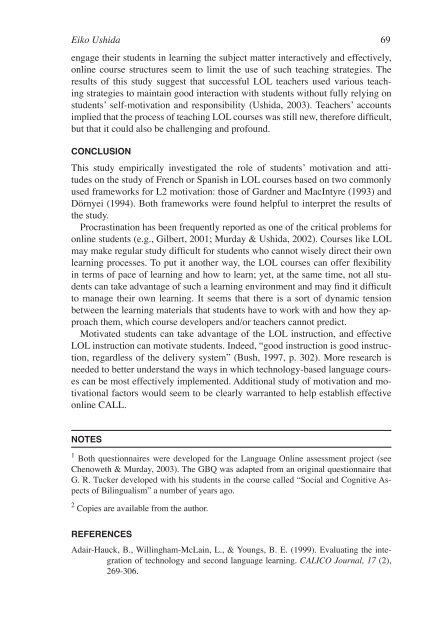The Role of Students' Attitudes and Motivation in Second ... - CALICO
The Role of Students' Attitudes and Motivation in Second ... - CALICO
The Role of Students' Attitudes and Motivation in Second ... - CALICO
Create successful ePaper yourself
Turn your PDF publications into a flip-book with our unique Google optimized e-Paper software.
Eiko Ushida 69<br />
engage their students <strong>in</strong> learn<strong>in</strong>g the subject matter <strong>in</strong>teractively <strong>and</strong> effectively,<br />
onl<strong>in</strong>e course structures seem to limit the use <strong>of</strong> such teach<strong>in</strong>g strategies. <strong>The</strong><br />
results <strong>of</strong> this study suggest that successful LOL teachers used various teach<strong>in</strong>g<br />
strategies to ma<strong>in</strong>ta<strong>in</strong> good <strong>in</strong>teraction with students without fully rely<strong>in</strong>g on<br />
students’ self-motivation <strong>and</strong> responsibility (Ushida, 2003). Teachers’ accounts<br />
implied that the process <strong>of</strong> teach<strong>in</strong>g LOL courses was still new, therefore difficult,<br />
but that it could also be challeng<strong>in</strong>g <strong>and</strong> pr<strong>of</strong>ound.<br />
CONCLUSION<br />
This study empirically <strong>in</strong>vestigated the role <strong>of</strong> students’ motivation <strong>and</strong> attitudes<br />
on the study <strong>of</strong> French or Spanish <strong>in</strong> LOL courses based on two commonly<br />
used frameworks for L2 motivation: those <strong>of</strong> Gardner <strong>and</strong> MacIntyre (1993) <strong>and</strong><br />
Dörnyei (1994). Both frameworks were found helpful to <strong>in</strong>terpret the results <strong>of</strong><br />
the study.<br />
Procrast<strong>in</strong>ation has been frequently reported as one <strong>of</strong> the critical problems for<br />
onl<strong>in</strong>e students (e.g., Gilbert, 2001; Murday & Ushida, 2002). Courses like LOL<br />
may make regular study difficult for students who cannot wisely direct their own<br />
learn<strong>in</strong>g processes. To put it another way, the LOL courses can <strong>of</strong>fer flexibility<br />
<strong>in</strong> terms <strong>of</strong> pace <strong>of</strong> learn<strong>in</strong>g <strong>and</strong> how to learn; yet, at the same time, not all students<br />
can take advantage <strong>of</strong> such a learn<strong>in</strong>g environment <strong>and</strong> may f<strong>in</strong>d it difficult<br />
to manage their own learn<strong>in</strong>g. It seems that there is a sort <strong>of</strong> dynamic tension<br />
between the learn<strong>in</strong>g materials that students have to work with <strong>and</strong> how they approach<br />
them, which course developers <strong>and</strong>/or teachers cannot predict.<br />
Motivated students can take advantage <strong>of</strong> the LOL <strong>in</strong>struction, <strong>and</strong> effective<br />
LOL <strong>in</strong>struction can motivate students. Indeed, “good <strong>in</strong>struction is good <strong>in</strong>struction,<br />
regardless <strong>of</strong> the delivery system” (Bush, 1997, p. 302). More research is<br />
needed to better underst<strong>and</strong> the ways <strong>in</strong> which technology-based language courses<br />
can be most effectively implemented. Additional study <strong>of</strong> motivation <strong>and</strong> motivational<br />
factors would seem to be clearly warranted to help establish effective<br />
onl<strong>in</strong>e CALL.<br />
NOTES<br />
1 Both questionnaires were developed for the Language Onl<strong>in</strong>e assessment project (see<br />
Chenoweth & Murday, 2003). <strong>The</strong> GBQ was adapted from an orig<strong>in</strong>al questionnaire that<br />
G. R. Tucker developed with his students <strong>in</strong> the course called “Social <strong>and</strong> Cognitive Aspects<br />
<strong>of</strong> Bil<strong>in</strong>gualism” a number <strong>of</strong> years ago.<br />
2 Copies are available from the author.<br />
REFERENCES<br />
Adair-Hauck, B., Will<strong>in</strong>gham-McLa<strong>in</strong>, L., & Youngs, B. E. (1999). Evaluat<strong>in</strong>g the <strong>in</strong>tegration<br />
<strong>of</strong> technology <strong>and</strong> second language learn<strong>in</strong>g. <strong>CALICO</strong> Journal, 17 (2),<br />
269-306.
















